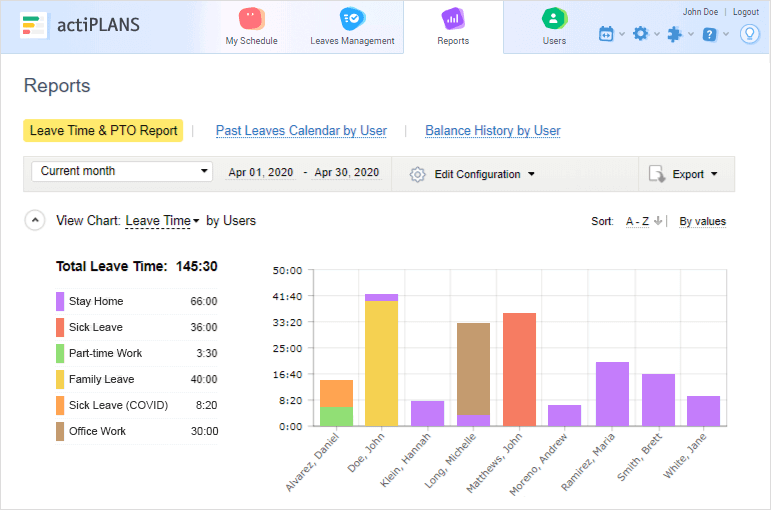Sickness absence is an inevitable part of reality for every employer. When an employee’s poor health prevents them from staying productive and performing their job responsibilities well (or at all), the wisest decision you can make is to give them a sufficient sick leave period.
However, sickness absence is a more complex issue than it may seem at first. It costs businesses a ton of money and may result from many preventable causes. So, let’s see how to manage sickness absence effectively, reduce the adverse effects of sickness absence on your organization and ensure your team members do not abuse it.

The Costs of Sickness Absence
Paid or unpaid, sickness absence is always costly.
According to the Institute of Employment Studies, large UK employers spend from 2 to 16% of their salary expenses on employee absence each year. These costs include the replacement of absent employees with other professionals and the statutory sickness pay, which UK businesses are required to provide to every sick team member by the law.
Another study revealed that US businesses lose from $16 to $286 per employee every year due to absenteeism associated with chronic diseases. The overall amount of absence costs depends on company size and tends to be higher for larger organizations. Since US employers are not legally obliged to compensate sick employees, the sickness absence costs, in their case, primarily result from decreased team productivity.
What Causes Sickness Absence
Employees may take sick leave due to a variety of reasons (and some of them are more valid than others):
- Actual health problems and medical appointments
- Need to take care of a sick family member
- Low job satisfaction, high workplace stress, and burnout
- Poor understanding of organizational time off policies
When an employee catches flu or gets injured, there’s not much an employer can do except to let them stay home and wish them a soon recovery. However, when a team member pulls a sickie simply because they don’t want to come to work or don’t know the repercussions of going absent without a reason, an employer needs to investigate the problem and take the situation under better control.
Check the tips listed below to learn how to do that.
How to Manage Sickness Absence: 8 Practical Tips
1. Design a comprehensive attendance policy
A well-drafted attendance policy is key to better absenteeism prevention. It explains how your company prefers to manage different types of time off and which attendance requirements your employees are expected to adhere to.
When creating such a policy, start with a short introduction to its purposes and the problems it aims to resolve. Then, indicate which absences you consider excused and unexcused and provide some explicit examples of both. For instance, long-term sick leave without a fit note can be viewed as an unexcused absence, while medically verified long-term sickness will be an excused one.
End the policy by describing all the disciplinary actions that should follow unexcused absences and excessive absenteeism. This will discourage your employees from going absent without a good reason and throwing a sickie too often.
2. Communicate the sickness absence rules to employees
Once all the relevant requirements and leave request procedures are registered in the attendance policy, share it with your team members and make certain they have free access to this vital document throughout their employment periods.
Remember to keep everyone posted about any changes in your approach to sick leave management. Plus, don’t forget to dedicate a special place to sickness absence rules in your employee handbook and communicate them consistently to all new hires.
3. Keep an accurate track of time off
When you know how many sick days and personal days off your employees take each month / year, detecting high absenteeism becomes as easy as pie. With precise and detailed time off data at hand, you can get a better insight into the problem and address it early on.
The question is: how to track time off in an accurate and efficient way? Such intuitive absence management software as actiPLANS gives the answer.
It includes a user-friendly leave scheduling feature that lets your team members schedule time off in just a few clicks. It supports automatic leave request approval and contains robust reporting functionality that clearly shows how many sick days, vacation days and other types of time off your employees take.
Click here to explore the essential time off reports featured in actiPLANS and learn how they may help you handle absenteeism better.

4. Request fit notes for long-term absences
A fit note is an official document issued to a sick person by a doctor. It provides all the necessary details about one’s health condition, including the info about their fitness for work.
In countries where employers are officially required to grant sick leave pay to employees, requesting fit notes is a normal practice. Yet even if your company only offers unpaid time off, it also makes total sense to ask for evidence of a staff member’s poor health when they intend to be absent for a significant period.
This simple measure helps to avoid the high costs of absenteeism, discourage deception, and reduce the risk of any disruption in the work process that an unnecessary employee absence is likely to cause.
5. Stay in touch with sick team members
Even a brief email or a phone call offers an excellent opportunity to express your concern for a sick employee’s health and provide them with some psychological support. Besides, maintaining contact with sick employees is a great way to show your interest in their quick return to work.
However, the balance is critical here. There’s no need to disturb your staff members when they’re on their rightful leave period. In fact, invading employees’ personal space is not only offensive but also a reason enough for filing an allegation of harassment. In other words, be sure to remind sick team members of yourself and their postponed job duties but do that in a perfectly polite and sensitive manner, don’t be demanding, and do mind your distance.
6. Carry out return-to-work interviews
Coming back to work after a long-term time off period is often overwhelming, especially if you spent all that time recovering from a disease. Hence, a short conversation with an employee before they jump on their tasks again can help them understand what happened at the workplace while they were away and secure a smoother transition into the productive mode.
Besides, return-to-work interviews allow you to get a better insight into an employee’s reasons for absence, the nature of their disease, and whether some of the workplace factors had an adverse impact on their health. This info is key to preventing the recurrence of sickness absence and improving the overall environment in your organization.
7. Promote occupational health and employee well-being
Excess workplace stress and burnout increase the risk of sickness absence by a large degree. And it’s in your power as an employer to reduce this risk through effective workload management, adequate staffing, positive organizational culture, and corporate wellness programs:
- Allocate a fair number of tasks to employees and set realistic deadlines for them to keep work-related stress under better control.
- Make sure your staffing needs are fully covered, there are enough people to help your business achieve its performance goals, and no one has to work overtime.
- Address interpersonal conflicts in the team right away and give your staff members plenty of chances to bond and form meaningful relationships with each other.
- Embrace flexible work arrangements – they allow for a better work-life balance and increase employees’ job satisfaction.
- Introduce such employee benefits as free healthy meals, gym memberships, and workplace counseling to help your team members stay physically and mentally sound.
8. Discourage presenteeism
Presenteeism refers to a situation when a person is present at work while sick. It mostly happens in those workplace cultures where managers reward overachievers and see any employee absence as a sign of poor performance.
The problem is that presenteeism is always counterproductive. When a team member is in a bad condition and has no energy to work, they obviously can’t do their job well and are at a higher risk of making serious mistakes.
To save your business from extra troubles, allow your employees to stay home in peace whenever they feel sick. Let them know that doing so is normal: use any opportunity to tell them that their health and well-being are important and try your best to establish a people-oriented culture in your company.
Conclusion
While sickness absence is unavoidable, the way you manage it determines which overall impacts it will have on your organization and employees. Lower costs and higher team morale are guaranteed when you use the eight tips we gave you in this post.
So, how to manage sickness absence well?
Define and document your sickness absence rules, communicate with your employees about the matter, and emphasize how important their well-being is. Most importantly, track any instance of sickness absence consistently and accurately – this data will help you detect high absenteeism and take it under better control.
Need an effective solution for sick leave management? actiPLANS is up for grabs! Sign up for a free online trial to check it out in action.



